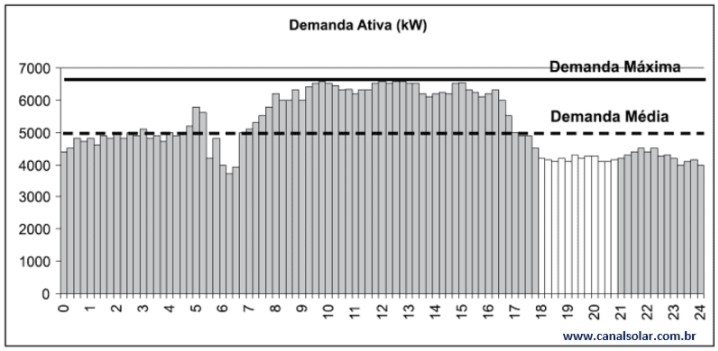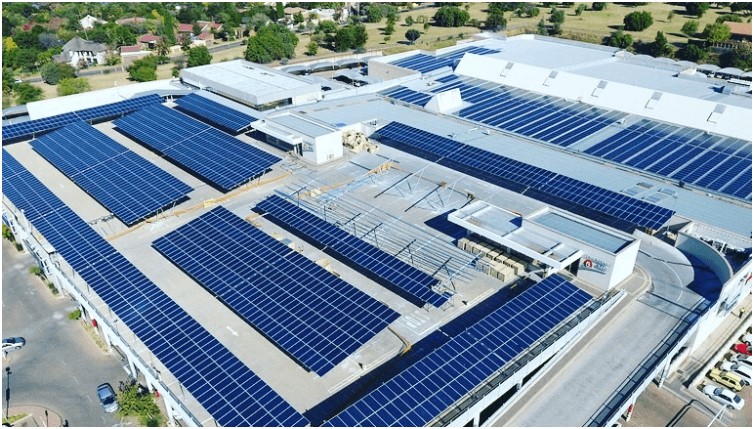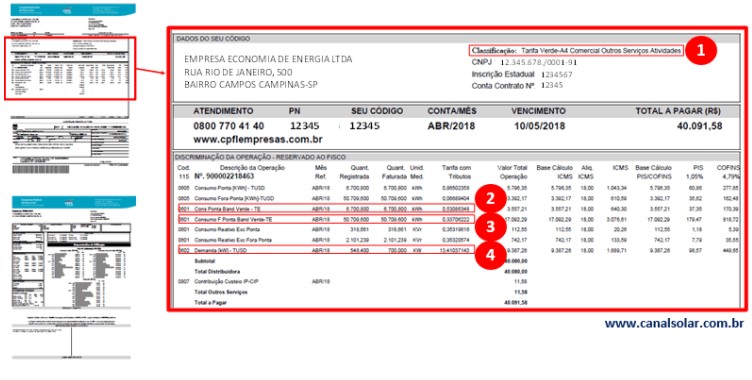Consumers in group A are those who have a medium voltage supply (higher than 2.3 kV). This category includes medium and large consumers such as industries, shopping centers, universities, supermarkets and large rural properties, among others.
These customers receive medium voltage electricity and have their own transformer to step it down to 127 V, 220 V or 380 V – low voltage, levels at which actual consumption occurs.
Group A customers have their bill divided into two parts, as they pay for the energy consumed (variable) and also pay for the contracted demand (fixed).
Energy tariffs and contracted demand may vary according to the period of the day in which consumption or demand occurred, the so-called tariff stations (peak hours and off-peak hours).
To learn more about contracted demand, peak hours and off-peak hours, read the article Reading and Interpreting Energy Invoices.
Many people confuse contracted demand with consumed energy. Therefore, it is important to remember that contracted demand is power (measured in kW).
This power is related to the consumer's installed load, that is, to the quantity and power of the equipment that the consumer has. On the other hand, the energy consumed is measured in kWh. Energy is associated with the consumer's monthly consumption.
The group A consumer pays for both things, for the right to have a contracted demand (kW), which guarantees that all their equipment and machines can be connected, in addition to paying for the energy consumed monthly, which is a variable amount.
ANEEL Normative Resolutions 482 and 687
These two resolutions from ANEEL (National Electric Energy Agency) determine some important points for group A consumers who want to install an SFV (photovoltaic system):
- The power limit of the photovoltaic system that can be installed by the customer is equal to the value of the contracted demand (power) in kW;
- The consumer will always pay the contracted demand, regardless of how much energy they consume per month;
- Compensation for injected energy must first occur at the tariff station where generation occurred. In other words: compensation for energy credits must primarily be made using the value of the energy at the time it was produced. In the case of photovoltaic systems, generation takes place during the day, during off-peak hours (the period when there is more sunlight). This is a bit bad for photovoltaic systems, as they generate during the day (when energy is cheaper), but we would like to use the compensated energy at night (when we pay more for energy);
- Compensation for energy consumed during peak hours will only occur after full compensation for energy consumed during off-peak hours (tariff station at which energy generation occurred). This compensation will be made according to the correction factor given by energy tariffs at peak and off-peak times (TE Ponta / TE Fora Ponta);
- Free consumers – consumers who purchase energy on Mercado Livre – cannot participate in the energy compensation system. This does not prevent them from installing a photovoltaic system, but the rules and variables are different.
These rules need to be taken into consideration to correctly size the SFV.
Contracted demand

For example, a consumer with a contracted demand of 200 kW can install a solar system with an AC power of a maximum of 200 kW.
If the project's AC power exceeds the contracted demand, the consumer must request an increase in this demand from the energy concessionaire.
This increase request must occur before installing the photovoltaic system. Only after the concessionaire responds to the increase in demand can the consumer be sure whether they will be able to install the desired photovoltaic system.
In some cases, increased demand is denied by the concessionaire for technical reasons. In many cases, the increase in demand is accompanied by the replacement of the transformer and the renovation of the customer's power cabinet, which generates additional costs for the photovoltaic project.
A consumer with a contracted demand of 200 kW, for example, who now plans to connect a photovoltaic system with an AC power of 250 kW, must in this case request an increase in contracted demand to at least 250 kW.
It should be noted that the consumer pays for the demand. Normally the return from the photovoltaic system compensates for the additional cost of the increase in contracted demand.
The increase in contracted demand is conditioned on the physical structure of the concessionaire and also the consumer, especially the power of the transformer(s) connecting to the distribution network.
For example, a consumer who has a 225 kVA transformer cannot claim a contracted demand of 250 kW, as their transformer would not support 250 kW of active power.
In this case, before proceeding with the increase in contracted demand, the consumer will need to increase the load – increasing the transformer power and possibly adapting input, protection and measurement cables.
In summary, the installation and request for access to the photovoltaic system will only be possible after the increase (exchange) of the transformer and authorization for increased demand contracted by the concessionaire.
As a rule, concessionaires allow load increase and contracted demand increase processes to occur simultaneously. Requesting access to the photovoltaic system is generally only possible after the contracted increase in demand has been completed.
Availability of physical space
Another factor that can limit installation power is the availability of area for installing the panels. In this analysis, the area that the customer has available (on the roof or ground) must be compared with the area required for the installation of the panels, taking into account the type of fixing structures and the spacing between the panel lines, necessary to allow maintenance of the photovoltaic system.
In the case of installation on the ground, the corridor area (space between the rows of panels), the area of the streets surrounding the solar plant and the area occupied by electrocenters and inverters must also be taken into account. Let's see below some examples of SFV sizing for group A consumers.
Sizing for full energy compensation without increasing contracted demand
We will take into consideration a consumer located in the CPFL Paulista concession area, located in Campinas (SP), with the following energy bill.

- Tariff type: Green seasonal time [1];
- TE Tip Tariff: R$ 0.530 [2];
- TE Off-Tip Tariff: R$ 0.337 [3];
- Contracted Demand: 700 kW [4];
- Average Consumption Tip: 4,912 kWh [5];
- Average off-peak consumption: 47,782 kWh [6].
Average irradiance in Campinas, used in sizing the PV system: 4.91 kWh/m2 per day (value extracted from the database available at http://www.cresesb.cepel.br/index.php#data).
Using the data above, we can calculate the power required to meet the total consumption of this customer:
DC power of the PV system = Required generation / (Irradiance x (1 – Losses)
In the equation above we have the following definitions:
- DC Power: Power of the PV system at the output of the inverters (kW);
- Required generation: amount of energy that the customer needs to generate monthly (kWh per month). This value is the average of monthly consumption extracted from the customer's electricity bill, with the application of the correction factor that takes into account peak and off-peak times;
- Irradiance: value of available solar energy, obtained from a database or solarimetric map (kWh/m2 per day);
- Losses: losses involved in the system, normally around 15% (thermal losses, inverter efficiency losses, etc.).
A required generation will be equal to the average monthly consumption, taking into account the correction factor (FC) for compensation during peak hours:
FC = TE Tipa / TE Fora Ponta = 0.530 / 0.337 = 1.573
Thus, we can determine the required generation:
Required generation = Average Off-Tip Consumption + (FC x Average On-Tip Consumption)
In the example considered we have:
Required generation = 47782 + (1.573 x 4912) = 55509 kWh/month
For calculation purposes, we transform the necessary generation, expressed here on a monthly time basis, to a daily time basis, simply dividing this value by the 30 days of a month.
Returning to the initial equation, considering system losses of 15% and substituting the values, we find the necessary power:
PV system DC power = 1850 / [ 4.91 x (1 – 0.15) ] = 443.27 kWp
The DC power value calculated above must be adjusted according to the power of the photovoltaic panels chosen to make up the system. For example, we can use 370 W panels, which would allow us to use 1,200 panels, with a total system power of 444 kWp.
The power of photovoltaic panels used in the system is also called the DC power of the system (direct current power) or peak power of the PV system.
We also need to define the AC power of the PV system, which is the total power at the outputs of the inverters used in the system. The total power output of the inverter inverters can be calculated using a factor overload of 25% (typical value):
PV system AC power = PV system DC power / 1.25
In the example considered we have:
PV system AC power = 355.2 kW
In a similar way to the adjustment made to DC power, we make the same adjustment to AC power. Taking into account an inverter with an AC power of 60 kW, for example, we can use 6 inverters, which would give us a total AC power of 360 kW.
As we saw previously, the maximum power of the photovoltaic system is limited by the contracted demand. In this way, we compare the system's AC power (360 kW) with the contracted demand (700 kW). In this case, we see that the AC power of the system is lower than the contracted demand, and installation is possible without any changes in this regard. It must also be checked whether the client has available space to install the proposed photovoltaic system.
Sizing for full energy compensation with increased contracted demand
Let's now size the system whose energy bill is seen below, from a customer who is also located in the region of Campinas (SP).
We have the following information:
- Tariff type: Green seasonal time;
- TE Tip Tariff: R$ 0.560;
- TE Off-Tip Tariff: R$ 0.362;
- Contracted Demand: 200 kW;
- Average Consumption Tip: 8,500 kWh;
- Average off-peak consumption: 70,000 kWh.
Once again we have the average irradiance in Campinas equal to 4.91 kWh/m2 per day (extracted from the database http://www.cresesb.cepel.br/index.php#data).
With all this information, simply apply the same equations presented in the previous case and we will have the following configuration:
FC = TE tip / TE outside the tip = 0.560 / 0.362 = 1.547
Required generation = 70000 + (1.547 x 8500) = 83150 kWh/month
Let's consider system losses of 15% once again. Just for didactic reasons and to practice in a different way, we will use a monthly time base instead of the daily one that was used in the previous calculation. To do this, simply multiply the daily irradiance by 4.91 kWh/m2 by 30, finding 147.3 kWh/m2 a month.
PV system DC power = 83150 / [ 147.3 x (1 – 0.15) ] = 664.11 kWp
Once again, we will use the same 370 Wp panels and adjust the DC (peak) power value of the SFV according to the number of panels needed. This way we could use 1,800 panels, with a total system power of 666 kWp.
Now that we know the DC power (peak power value of the solar panels, kWp) let's calculate the AC power of the photovoltaic system (output power of the inverters):
AC power of the PV system = DC power of the PV system / 1.25 = 666 / 1.25 = 533 kWp
We will use the same 60 kW inverters used in the previous example, which allows us to use 9 inverters, having a total AC power of 540 kW. In this case study, we see that the AC power of the PV system (540 kW) is much higher than the contracted demand (200 kW).
This installation will only be possible if there is an increase in contracted demand to at least 540 kW. In this case, an increase in load is likely to be necessary.
After sizing the PV system according to the required generation, as we have done so far, it must also be checked whether the client has an area available to install the proposed photovoltaic system.
Sizing according to the limit of contracted demand
When the customer does not receive authorization from the concessionaire to increase demand or when the customer does not want to increase the load (changing the transformer and readjusting the input standard), an alternative is to size the system within the limit of the existing contracted demand.
In this case, we do the calculation in reverse, starting with AC power. The maximum AC power will be equal to 200 kW, for example (current contracted customer demand), and the DC power will be given by:
PV system DC power = PV system AC power x 1.25 = 225 kWp
Obviously, with a lower power, the system will generate less energy, which is calculated as follows:
Generation = DC power of the PV system x Irradiance x (1 – Losses)
In this example we will have:
Generation = 28171 kWh/month
It is worth remembering that the FC (correction factor) for compensation at peak times depends solely and exclusively on the TE's (peak and off-peak), and not on the full fares (full fares are made up of TE's and TUSD's.
If the TE's and TUSD's are not clearly listed on the invoice, it is necessary to find the TE's values in ANEEL's tariff processes clicking here.
To deepen your knowledge about sizing and optimization strategies for photovoltaic systems, consider investing in solar energy courses and training. These programs provide valuable insights into design and operation best practices, helping you make the most of your system within existing constraints.





















14 Responses
Good morning
When the Company has a free market, how are the calculations made?
Is the demand fee reduced by half?
Hello, Junior, how are you? No, the contracted demand value remains the same
Excellent article, a very objective class.
I would just like it to be clarified whether the output power limit of the inverter (or set of inverters) can be equal to the power of the company's input transformer or whether a safety margin must be left? For example, is it allowed by power utilities to connect a 75 KW inverter to a 75 KVA input transformer?
Yes! The inverter power limit is the transformer power
Good afternoon, I would like to know where I can get bibliographical references about the TEP/TEFP ratio?
ANEEL Thematic Notebooks. Distributed Micro and Minigeneration. Electrical Energy Compensation System. 2nd Edition
https://www.aneel.gov.br/documents/656877/14913578/Caderno+tematico+Micro+e+Minigera%C3%A7%C3%A3o+Distribuida+-+2+edicao/716e8bb2-83b8-48e9-b4c8-a66d7f655161
Hello!
Does anyone have a recommendation for a company that designs and approves the group A system.
Campinas region.
send by email to [email protected] that we can recommend some companies.
Onnes Engenharia. It is a company specialized in micro and mini-generation photovoltaic projects. Contact them via this link: https://bio.site/onnes
The adjustment factor is the energy tariff at the time it was generated divided by the energy tariff where I want to compensate, in our case, TEFP/TEP.
https://viniciusayrao.com.br/como-calcular-fv-para-clientes-do-grupo-a/
The calculation method presented in this article is correct. You can write the FC as stated, making the necessary adjustments to the equation.
Goodnight!
My name is José Robson and I would like to ask you a question about the compensation factor or adjustments (TE tip and TE outside the tip). I noticed that in other Blogs, they used this formula, where the TE tip was in the denominator and the TE outside the tip was in the numerator. In other words, we would certainly have very different values. What would be the correct way?
FC = TE tip / TE outside the tip or FC = TE outside the tip / TE tip.
A big hug!
The calculation method presented in this article is correct. You can write the FC as stated, making the necessary adjustments to the equation.